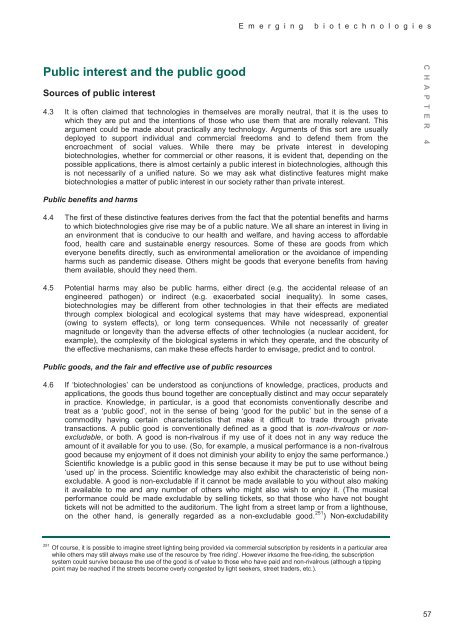Emerging biotechnologies: full report - Nuffield Council on Bioethics
Emerging biotechnologies: full report - Nuffield Council on Bioethics
Emerging biotechnologies: full report - Nuffield Council on Bioethics
You also want an ePaper? Increase the reach of your titles
YUMPU automatically turns print PDFs into web optimized ePapers that Google loves.
E m e r g i n g b i o t e c h n o l o g i e s<br />
Public interest and the public good<br />
Sources of public interest<br />
4.3 It is often claimed that technologies in themselves are morally neutral, that it is the uses to<br />
which they are put and the intenti<strong>on</strong>s of those who use them that are morally relevant. This<br />
argument could be made about practically any technology. Arguments of this sort are usually<br />
deployed to support individual and commercial freedoms and to defend them from the<br />
encroachment of social values. While there may be private interest in developing<br />
<str<strong>on</strong>g>biotechnologies</str<strong>on</strong>g>, whether for commercial or other reas<strong>on</strong>s, it is evident that, depending <strong>on</strong> the<br />
possible applicati<strong>on</strong>s, there is almost certainly a public interest in <str<strong>on</strong>g>biotechnologies</str<strong>on</strong>g>, although this<br />
is not necessarily of a unified nature. So we may ask what distinctive features might make<br />
<str<strong>on</strong>g>biotechnologies</str<strong>on</strong>g> a matter of public interest in our society rather than private interest.<br />
C H A P T E R 4<br />
Public benefits and harms<br />
4.4 The first of these distinctive features derives from the fact that the potential benefits and harms<br />
to which <str<strong>on</strong>g>biotechnologies</str<strong>on</strong>g> give rise may be of a public nature. We all share an interest in living in<br />
an envir<strong>on</strong>ment that is c<strong>on</strong>ducive to our health and welfare, and having access to affordable<br />
food, health care and sustainable energy resources. Some of these are goods from which<br />
every<strong>on</strong>e benefits directly, such as envir<strong>on</strong>mental ameliorati<strong>on</strong> or the avoidance of impending<br />
harms such as pandemic disease. Others might be goods that every<strong>on</strong>e benefits from having<br />
them available, should they need them.<br />
4.5 Potential harms may also be public harms, either direct (e.g. the accidental release of an<br />
engineered pathogen) or indirect (e.g. exacerbated social inequality). In some cases,<br />
<str<strong>on</strong>g>biotechnologies</str<strong>on</strong>g> may be different from other technologies in that their effects are mediated<br />
through complex biological and ecological systems that may have widespread, exp<strong>on</strong>ential<br />
(owing to system effects), or l<strong>on</strong>g term c<strong>on</strong>sequences. While not necessarily of greater<br />
magnitude or l<strong>on</strong>gevity than the adverse effects of other technologies (a nuclear accident, for<br />
example), the complexity of the biological systems in which they operate, and the obscurity of<br />
the effective mechanisms, can make these effects harder to envisage, predict and to c<strong>on</strong>trol.<br />
Public goods, and the fair and effective use of public resources<br />
4.6 If ‘<str<strong>on</strong>g>biotechnologies</str<strong>on</strong>g>’ can be understood as c<strong>on</strong>juncti<strong>on</strong>s of knowledge, practices, products and<br />
applicati<strong>on</strong>s, the goods thus bound together are c<strong>on</strong>ceptually distinct and may occur separately<br />
in practice. Knowledge, in particular, is a good that ec<strong>on</strong>omists c<strong>on</strong>venti<strong>on</strong>ally describe and<br />
treat as a ‘public good’, not in the sense of being ‘good for the public’ but in the sense of a<br />
commodity having certain characteristics that make it difficult to trade through private<br />
transacti<strong>on</strong>s. A public good is c<strong>on</strong>venti<strong>on</strong>ally defined as a good that is n<strong>on</strong>-rivalrous or n<strong>on</strong>excludable,<br />
or both. A good is n<strong>on</strong>-rivalrous if my use of it does not in any way reduce the<br />
amount of it available for you to use. (So, for example, a musical performance is a n<strong>on</strong>-rivalrous<br />
good because my enjoyment of it does not diminish your ability to enjoy the same performance.)<br />
Scientific knowledge is a public good in this sense because it may be put to use without being<br />
‘used up’ in the process. Scientific knowledge may also exhibit the characteristic of being n<strong>on</strong>excludable.<br />
A good is n<strong>on</strong>-excludable if it cannot be made available to you without also making<br />
it available to me and any number of others who might also wish to enjoy it. (The musical<br />
performance could be made excludable by selling tickets, so that those who have not bought<br />
tickets will not be admitted to the auditorium. The light from a street lamp or from a lighthouse,<br />
<strong>on</strong> the other hand, is generally regarded as a n<strong>on</strong>-excludable good. 251 ) N<strong>on</strong>-excludability<br />
251 Of course, it is possible to imagine street lighting being provided via commercial subscripti<strong>on</strong> by residents in a particular area<br />
while others may still always make use of the resource by ‘free riding’. However irksome the free-riding, the subscripti<strong>on</strong><br />
system could survive because the use of the good is of value to those who have paid and n<strong>on</strong>-rivalrous (although a tipping<br />
point may be reached if the streets become overly c<strong>on</strong>gested by light seekers, street traders, etc.).<br />
57
















